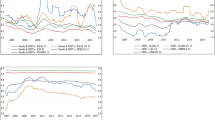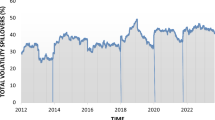Abstract
The primary aim of this research is to compute implied volatility based on a stochastic contingent claim valuation model proposed by Dixit and Pindyck (1994). Over the sample period of 1984 to 1997, and with approximately 20,000 commercial property transactions in the United Kingdom, we find that implied volatility of rental returns is in the region of 24.83 percent. Over the same sample period, the historical and conditional standard deviations of the log returns of transaction-based rental series is estimated to be 15.60 percent and 35.64 percent, respectively. The tests of information content of these risk measures show that there is strong orthogonality in the information impounded in implied volatility estimates compared to that contained in historical standard deviations.
Similar content being viewed by others
References
Baum, A.E. (1989). A Critical Examination of the Measurement of Property Investment Risk. Discussion Paper 22, Department of Land Economy, University of Cambridge.
Blundell, G., and C. Ward. (1987). “Property Portfolio Allocation: A Multi-factor Model,” Land Development Studies 4(2), 145-156.
Bollerslev, T. (1986). “Generalized Autoregressive Conditional Heteroskedasticity,” Journal of Econometrics 31, 307-327.
Bollerslev, T., R. F. Engle, and J. M. Wooldridge. (1988). “A Capital Asset Pricing Model with Time Varying Covariance,” Journal of Political Economy 96, 116-131.
Chiras, D., and S. Manaster. (1978). “The Information Content of Option Prices and a Test of Market Ef®ciency,” Journal of Financial Economics 6, 213-234.
Day, T. E., and C. M. Lewis. (1992). “Stock Market Volatility and the Information Content of Stock Index Options,” Journal of Econometrics 52, 267-287.
Dixit, A., and R. S. Pindyck. (1994). Investment Under Uncertainty. Princeton: Princeton University Press.
Engle, R. F. (1982). “Autoregressive Conditional Heteroscedasticity with Estimates of the Variance of UnitedKingdom Inflation,” Econometrica 50, 987-1007.
Engle, R. F., D. Lilien, and R. Robins. (1987). “Estimating Time Varying Risk Premia in the Term Structure: The ARCH-M Model,” Econometrica 55, 391-407.
Latane, H., and R. Rendleman. (1976). “Standard Deviations of Stock Price Ratios Implied in Option Prices,” Journal of Finance 31(2), 369-381.
Lizieri, C., and S. Satchell. (1992). “The Variance of Property Returns: Some Problems of Time-Weighted Measures,” Journal of Property Valuation and Investment 10(2), 541-547.
McDonald, R., and D. Siegel. (1986). “The Value ofWaiting to Invest.” Quarterly Journal of Economics 101(4), 707-727.
Nanthakumaran, N., and G. Newell. (1995). “An Empirical Evaluation of UK Property Performance Indices,” Proceedings of the “The Cutting Edge” Property Research Conference of The Royal Institution of Chartered Surveyors. (pp. 75-92), The Royal Institute of Chartered Surveyors, Aberdeen, Scotland.
Nelson, D. B. (1991). “Conditional Heteroskedasticity in Asset Returns: A New Approach,” Econometrica 59, 347-370.
Pindyck, R. S. (1991). “Irreversibility, Uncertainty, and Investment,” Journal of Economic Literature 29, 1110-1152.
Ross, S. A., and R. C. Zisler. (1991). “Risk and Return in Real Estate,” Journal of Real Estate Finance and Economics 4, 175-190.
Schmalensee, R., and R. P. Trippi. (1978). “Common Stock Volatility Expectations Implied by Option Premia,” Journal of Finance 32, 129-147.
Schwartz, E. S. (1997). “The Stochastic Behavior of Commodity Prices: Implications for Valuation and Hedging,” Journal of Finance 52(3), 923-973.
Author information
Authors and Affiliations
Rights and permissions
About this article
Cite this article
Patel, K., Sing, T.F. Implied Volatility in the U.K. Commercial Property Market: Empirical Evidence Based on Transaction Data. The Journal of Real Estate Finance and Economics 20, 5–24 (2000). https://doi.org/10.1023/A:1007824720502
Issue Date:
DOI: https://doi.org/10.1023/A:1007824720502




